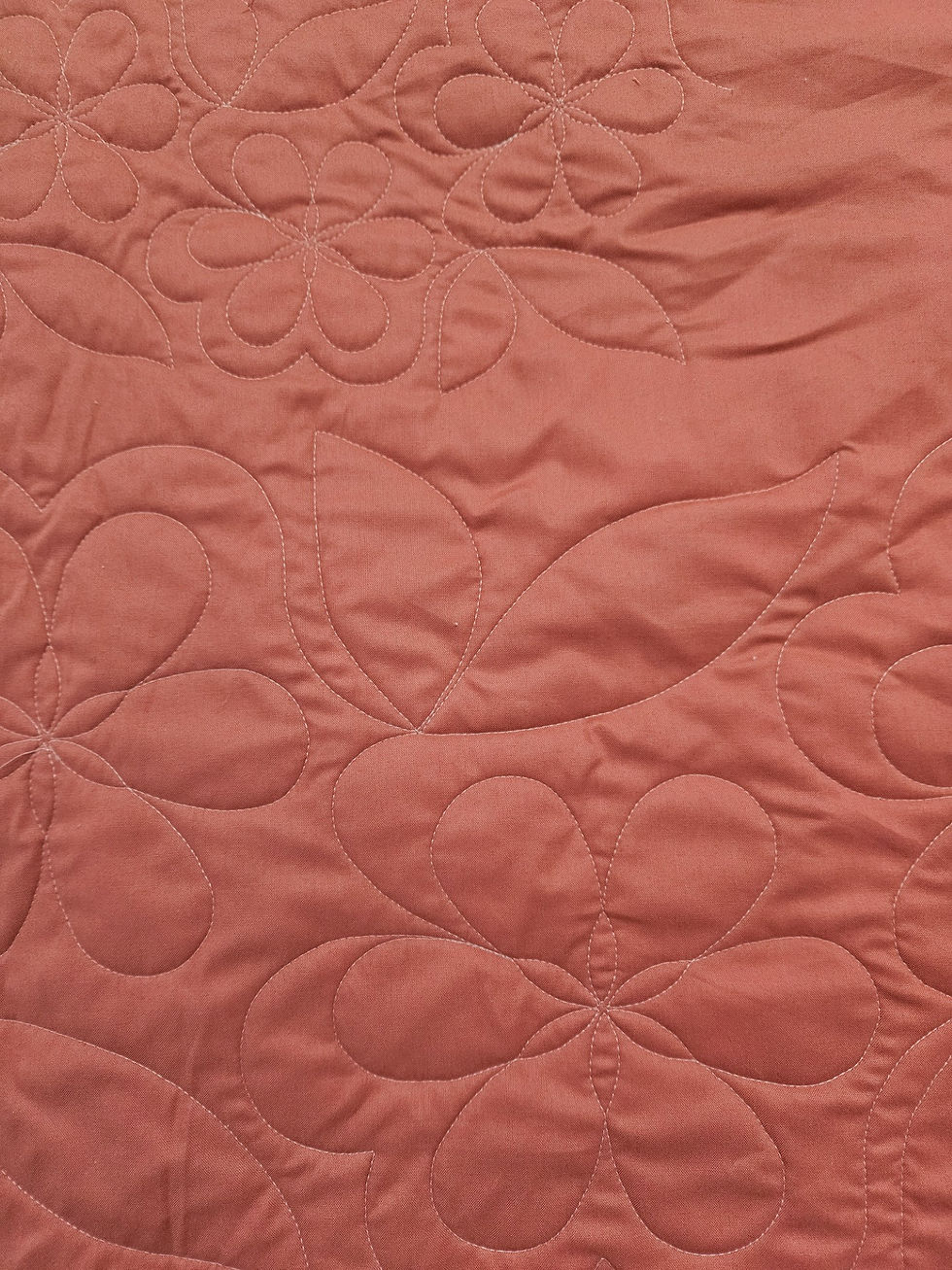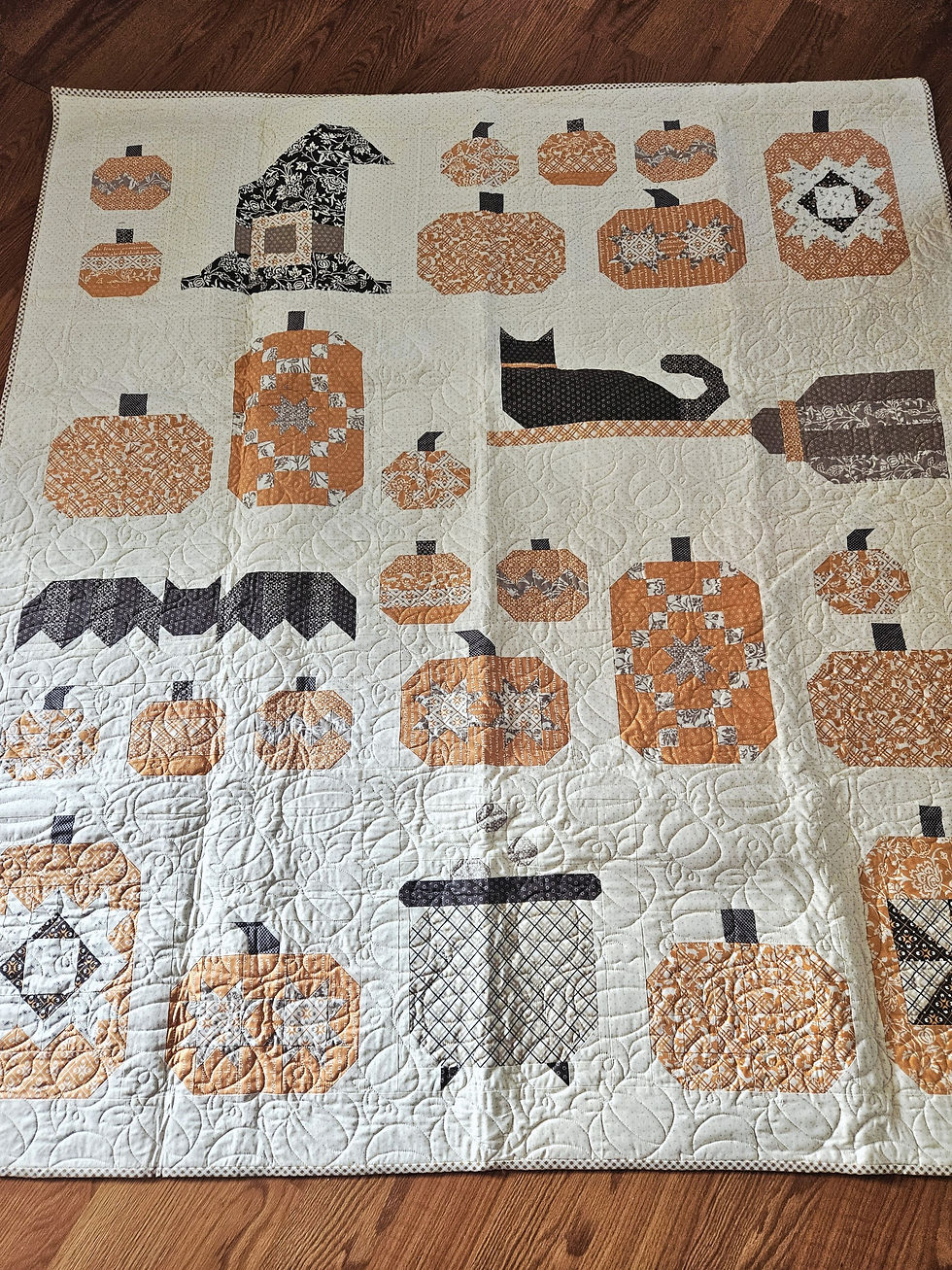Let's Get Batty!!!
- Debra Howard
- Aug 7
- 5 min read
August 7, 2025

I thought I'd chat about some things I like to take into consideration when I get ready to have a project quilted. A lot of these points will boil down to your own preference but they are still things to consider.
First off is the batting. There are so many types of batting available now days. Everything from polyester, cotton, wool, bamboo, silk, as well as blends of these fibers.
Polyester:
Once the most common type of batting used it seems to have taken a bit of a dive in popularity as people are leaning towards more natural fibers. It may still be exactly what you want for certain projects. It has no shrinkage, and is widely available in many thicknesses. It is very good to use in projects that will get a lot of wear and tear (picnic quilts, the dog blanket etc) but you could also consider it for wall hangings as it retains its shape very well. And if you are looking for a softer, loftier quilt, this is definitely the way to go. Since polyester has a tendency to have a bit more loft I don't personally like it for tablerunners or anything that I may want something to sit securely on the top. I find a narrow vase of flowers has more of chance of tipping over when placed on polyester batting than the flatter 80/20 batting option.
Cotton:
100% cotton is an option if you are looking for that "vintage" look when you wash your quilt. That great crinkly look magically appears with washing. It also gets softer with each washing. It is available in black as well as the lighter options, it does have quite a bit of lint, and has a tendency to hold the fold creases. If you are going with a "natural" cotton watch out for the seed husks that can be present. These pesky little flecks can show through a light white background fabric. A true 100% cotton batting also won't contain scrim as that is a polyester fiber. (Scrim is a thin mesh layer added to some battings to make it possible to quilt a little less dense, the fibers don't separate, distort or stretch as much)
Bamboo:
This has really become popular in the last while. It is really suited to warmer climates due to it's natural cooling abilities and lighter weight feel. It is very resistant to mildew and mold and dries super quick.
Silk:
Is very soft and has a wonderful drape. This makes it a great option for show quality quilts. It is definitely on the more expensive side, some brands I looked at were actually about double in price compared to bamboo and 80/20.
Wool:
Another great natural fiber option. It breaths very well while offering great warmth without being super heavy or bulky. It is often used when you want to highlight your stitching (as in big stitch quilting) and hand quilters love how easy it is to stitch. It is another fairly crease resistant batting so stands up well to being folded and stored. The fibers are hollow and trap air which gives it the insulating effect. Take note when you purchase wool batting whether or not it has been pre-shrunk as it will shrink a fair amount. It can also be an allergy risk for some people. It seems to sit in the somewhere in the middle price-wise, cheaper than silk but more expensive than bamboo or 80/20.
Blends:
Probably one of the most common battings used today is the 80/20 blend of cotton and polyester. This gives you a nice balance between the two different fibers. The touch of polyester helps reduce shrinkage and gives it a bit more durability which helps when washing frequently. The cotton contributes to breathability. Some quilters find the natural cream color doesn't look as good under a white background but you can get the 80/20 in a white version.
***Is there a right and wrong side to batting? There is if it has been needle punched to help hold the fibers together and make it more durable. It can be a very subtle thing to see but you can if you look close and you will also be able to feel it with your hand. The dimples, or little raised dots are considered the wrong side and that side is typically placed against the quilt back, not the quilt top. See if you can spot the fine dimples on the left of this picture? There is a subtle different appearance compared to the right of this picture which is the considered the "right" side of the batting.

Quilting Density:
The next thing I thought we'd chat about is quilting density. This refers to how close together the lines of quilting stitches will be. Take a look at this picture of the exact same quilting design done on a scrap of fabric at two different densities.

Smaller projects seem to look better when the quilting is also on a smaller scale, it seems to be more proportional and pleasing to the eye. It will also give you the benefit of the table runner lying very flat which makes it great if you are planning on placing decorative items on top of it.

With a quilt, you will get a softer feel with a less dense quilting design. So if you want that cuddly soft feel, then quilt it with a less dense design that has more space between the rows of stitching. So it makes sense that if you may want a decorative wall-hanging to be more densely quilted so it hangs lovely and flat. The extra stitching will also stabilize it more and prevent drooping or pull from the weight while hanging.
A more densely quilted piece will also photograph well and really showcases the project. More open quilted projects will showcase your fabric more. Densely quilted projects will also stand up better to more frequent washings.
It seems there has been more of lean to densely quilted projects in the last few years. It gives a more modern feel to your projects. Looser quilting gives a look that is more similar to the hand quilted appearance.
I must admit that although I like the 80/20 blend, I really don't like the creases or fold lines you see when you bring your quilt out of the linen closet. I haven't tried bamboo yet but it is on my bucket list, lol.

What is your favorite batting?
Twila

We invite to you check out Quilts By The Bay Friday Night Frenzy live show on Facebook for a fun evening of great sales, new product unboxing and lots of laughs! Every Friday night 7pm Atlantic Standard Time. This link will take you to the facebook page:





Your different topics are fabulously full of great information. Thank you so much !